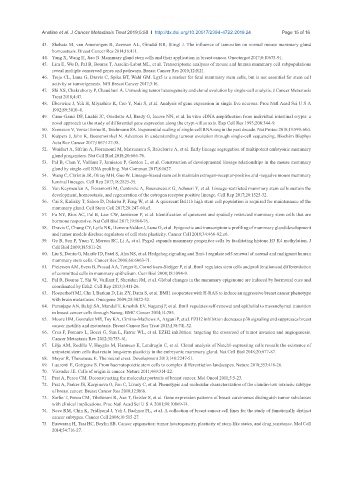Page 370 - Read Online
P. 370
Anstine et al. J Cancer Metastasis Treat 2019;5:50 I http://dx.doi.org/10.20517/2394-4722.2019.24 Page 15 of 16
43. Shehata M, van Amerongen R, Zeeman AL, Giraddi RR, Stingl J. The influence of tamoxifen on normal mouse mammary gland
homeostasis. Breast Cancer Res 2014;16:411.
44. Yang X, Wang H, Jiao B. Mammary gland stem cells and their application in breast cancer. Oncotarget 2017;8:10675-91.
45. Lim E, Wu D, Pal B, Bouras T, Asselin-Labat ML, et al. Transcriptome analyses of mouse and human mammary cell subpopulations
reveal multiple conserved genes and pathways. Breast Cancer Res 2010;12:R21.
46. Trejo CL, Luna G, Dravis C, Spike BT, Wahl GM. Lgr5 is a marker for fetal mammary stem cells, but is not essential for stem cell
activity or tumorigenesis. NPJ Breast Cancer 2017;3:16.
47. Shi XS, Chakraborty P, Chaudhuri A. Unmasking tumor heterogeneity and clonal evolution by single-cell analysis. J Cancer Metastasis
Treat 2018;4:47.
48. Eberwine J, Yeh H, Miyashiro K, Cao Y, Nair S, et al. Analysis of gene expression in single live neurons. Proc Natl Acad Sci U S A
1992;89:3010-4.
49. Cano-Gauci DF, Lualdi JC, Ouellette AJ, Brady G, Iscove NN, et al. In vitro cDNA amplification from individual intestinal crypts: a
novel approach to the study of differential gene expression along the crypt-villus axis. Exp Cell Res 1993;208:344-9.
50. Svensson V, Vento-Tormo R, Teichmann SA. Exponential scaling of single-cell RNA-seq in the past decade. Nat Protoc 2018;13:599-604.
51. Kuipers J, Jahn K, Beerenwinkel N. Advances in understanding tumour evolution through single-cell sequencing. Biochim Biophys
Acta Rev Cancer 2017;1867:127-38.
52. Wuidart A, Sifrim A, Fioramonti M, Matsumura S, Brisebarre A, et al. Early lineage segregation of multipotent embryonic mammary
gland progenitors. Nat Cell Biol 2018;20:666-76.
53. Pal B, Chen Y, Vaillant F, Jamieson P, Gordon L, et al. Construction of developmental lineage relationships in the mouse mammary
gland by single-cell RNA profiling. Nat Commun 2017;8:1627.
54. Wang C, Christin JR, Oktay MH, Guo W. Lineage-biased stem cells maintain estrogen-receptor-positive and -negative mouse mammary
luminal lineages. Cell Rep 2017;18:2825-35.
55. Van Keymeulen A, Fioramonti M, Centonze A, Bouvencourt G, Achouri Y, et al. Lineage-restricted mammary stem cells sustain the
development, homeostasis, and regeneration of the estrogen receptor positive lineage. Cell Rep 2017;20:1525-32.
56. Cai S, Kalisky T, Sahoo D, Dalerba P, Feng W, et al. A quiescent Bcl11b high stem cell population is required for maintenance of the
mammary gland. Cell Stem Cell 2017;20:247-60.e5.
57. Fu NY, Rios AC, Pal B, Law CW, Jamieson P, et al. Identification of quiescent and spatially restricted mammary stem cells that are
hormone responsive. Nat Cell Biol 2017;19:164-76.
58. Dravis C, Chung CY, Lytle NK, Herrera-Valdez J, Luna G, et al. Epigenetic and transcriptomic profiling of mammary gland development
and tumor models disclose regulators of cell state plasticity. Cancer Cell 2018;34:466-82.e6.
59. Gu B, Sun P, Yuan Y, Moraes RC, Li A, et al. Pygo2 expands mammary progenitor cells by facilitating histone H3 K4 methylation. J
Cell Biol 2009;185:811-26.
60. Liu S, Dontu G, Mantle ID, Patel S, Ahn NS, et al. Hedgehog signaling and Bmi-1 regulate self-renewal of normal and malignant human
mammary stem cells. Cancer Res 2006;66:6063-71.
61. Pietersen AM, Evers B, Prasad AA, Tanger E, Cornelissen-Steijger P, et al. Bmi1 regulates stem cells and proliferation and differentiation
of committed cells in mammary epithelium. Curr Biol 2008;18:1094-9.
62. Pal B, Bouras T, Shi W, Vaillant F, Sheridan JM, et al. Global changes in the mammary epigenome are induced by hormonal cues and
coordinated by Ezh2. Cell Rep 2013;3:411-26.
63. Hoenerhoff MJ, Chu I, Barkan D, Liu ZY, Datta S, et al. BMI1 cooperates with H-RAS to induce an aggressive breast cancer phenotype
with brain metastases. Oncogene 2009;28:3022-32.
64. Paranjape AN, Balaji SA, Mandal T, Krushik EV, Nagaraj P, et al. Bmi1 regulates self-renewal and epithelial to mesenchymal transition
in breast cancer cells through Nanog. BMC Cancer 2014;14:785.
65. Moore HM, Gonzalez ME, Toy KA, Cimino-Mathews A, Argani P, et al. EZH2 inhibition decreases p38 signaling and suppresses breast
cancer motility and metastasis. Breast Cancer Res Treat 2013;138:741-52.
66. Crea F, Fornaro L, Bocci G, Sun L, Farrar WL, et al. EZH2 inhibition: targeting the crossroad of tumor invasion and angiogenesis.
Cancer Metastasis Rev 2012;31:753-61.
67. Lilja AM, Rodilla V, Huyghe M, Hannezo E, Landragin C, et al. Clonal analysis of Notch1-expressing cells reveals the existence of
unipotent stem cells that retain long-term plasticity in the embryonic mammary gland. Nat Cell Biol 2018;20:677-87.
68. Mayor R, Theveneau E. The neural crest. Development 2013;140:2247-51.
69. Laurenti E, Gottgens B. From haematopoietic stem cells to complex differentiation landscapes. Nature 2018;553:418-26.
70. Visvader JE. Cells of origin in cancer. Nature 2011;469:314-22.
71. Prat A, Perou CM. Deconstructing the molecular portraits of breast cancer. Mol Oncol 2011;5:5-23.
72. Prat A, Parker JS, Karginova O, Fan C, Livasy C, et al. Phenotypic and molecular characterization of the claudin-low intrinsic subtype
of breast cancer. Breast Cancer Res 2010;12:R68.
73. Sorlie T, Perou CM, Tibshirani R, Aas T, Geisler S, et al. Gene expression patterns of breast carcinomas distinguish tumor subclasses
with clinical implications. Proc Natl Acad Sci U S A 2001;98:10869-74.
74. Neve RM, Chin K, Fridlyand J, Yeh J, Baehner FL, et al. A collection of breast cancer cell lines for the study of functionally distinct
cancer subtypes. Cancer Cell 2006;10:515-27.
75. Easwaran H, Tsai HC, Baylin SB. Cancer epigenetics: tumor heterogeneity, plasticity of stem-like states, and drug resistance. Mol Cell
2014;54:716-27.

